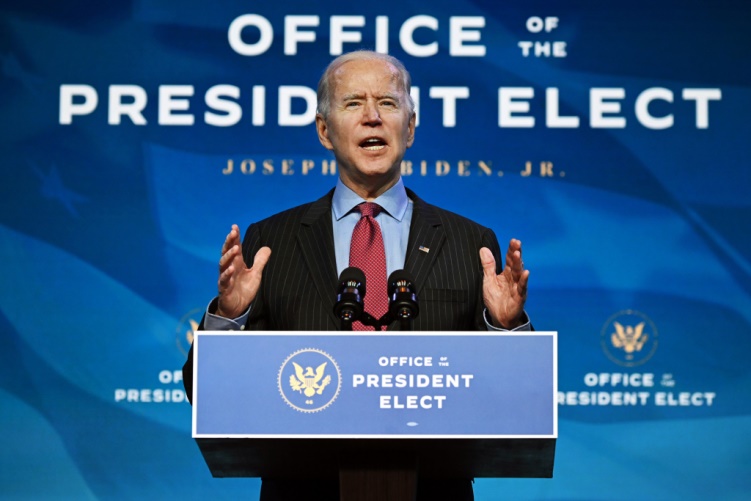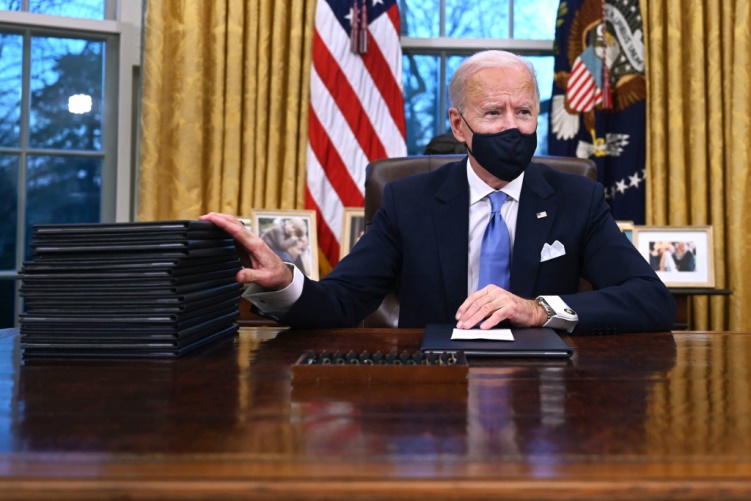不出所料,在喬?拜登的總統就職典禮上,女性的著裝吸引了很多關注。出席典禮的新任副總統賀錦麗(Kamala Harris)、前第一夫人米歇爾?奧巴馬、前國務卿希拉里?克林頓皆著一席紫色,其中必有涵義:可以肯定的是,紫色象征著團結,把共和黨的紅色和民主黨的藍色混合,紫色是最終的合成色;此外,紫色是婦女參政論者的標志色,賀錦麗身著的紫色還有向雪莉?奇澤姆致敬之意——奇澤姆是美國歷史上第一位當選國會議員,并宣布競選總統的黑人女性,紫色是她的鐘愛之色。
但是,典禮的主角——拜登的著裝似乎被遺忘在了角落。不過這也說得通,因為那只是一套100%符合標準的總統裝束。但實際上,從21個月前拜登宣布參選以來,他的著裝就一直在傳遞著信息,反映著他的戰略思維和個人自律。拜登的著裝歷程,能夠分為三個階段。

候選人時期的拜登,似乎就是一個來自斯克蘭頓的“普通小伙子”——但話說回來,其實也沒有那么普通。他遵循著管理咨詢行業長期以來的著裝要求:向客戶著裝看齊,但要更高級一點點。除了參加電視辯論和民主黨全國代表大會期間,拜登幾乎從不穿西裝、打領帶,但也不穿牛仔褲和運動鞋。在鏡頭前,拜登的著裝通常是一件深藍色夾克(一般是運動夾克,但沒有花哨的黃銅紐扣)、不配套的褲子,和一件開領的藍色或條紋襯衫。傳遞出的信息是“嚴肅,重要,但不古板”,拜登本人也堅守著這些關鍵詞。

當選總統之后的拜登,在2020年11月7日美聯社(Associated Press)宣布他勝選之后突然出現在公眾視線中。之后在公共場合出席時,拜登很少不打領帶,或穿著除了深色西裝以外的衣服。意圖很明確——某些人可能會質疑選舉結果,但請搞清楚,我就是下一任總統。
但此時,拜登還沒有正式登上總統席位,他的著裝也與這一過渡身份相符,并不會完全體現出“總統風格”:偶爾還會穿帶紐扣袖口的藍色襯衫,穿細條紋西服。他時常會打條紋狀的領帶,有點“總統風格”的味道了,但比厚重的純色要差幾分莊嚴感。對服裝了如指掌的人還觀察到,拜登領帶上的條紋走向為右上-左下,這是典型的美式風格,而走向相反的條紋(奧巴馬的所有條紋領帶皆是如此)則是英式風格。當然,這一點對絕大多數的人來說都太細節了。
美

就任總統后的拜登,才在著裝上完全走向“總統風格”:純深色西裝,配法式袖口的白襯衫,帶徽章的袖口鏈扣,“民主黨藍”領帶,擦得锃亮的黑色鞋子。透露出的信息很明確:放輕松,我的外表、舉止都將符合美國民眾對總統的期望。
著裝是一種語言,拜登和他的智囊團在這方面相當熟練。在著裝方面,華盛頓的女性政客一定會繼續吸引著最多的關注,但也請看一眼總統的穿著打扮吧——無論西裝顏色如何、襯衫是何種樣式、打領帶與否,它們都在有意地告訴我們一些信息。(財富中文網)
編譯:楊二一
不出所料,在喬?拜登的總統就職典禮上,女性的著裝吸引了很多關注。出席典禮的新任副總統賀錦麗(Kamala Harris)、前第一夫人米歇爾?奧巴馬、前國務卿希拉里?克林頓皆著一席紫色,其中必有涵義:可以肯定的是,紫色象征著團結,把共和黨的紅色和民主黨的藍色混合,紫色是最終的合成色;此外,紫色是婦女參政論者的標志色,賀錦麗身著的紫色還有向雪莉?奇澤姆致敬之意——奇澤姆是美國歷史上第一位當選國會議員,并宣布競選總統的黑人女性,紫色是她的鐘愛之色。
但是,典禮的主角——拜登的著裝似乎被遺忘在了角落。不過這也說得通,因為那只是一套100%符合標準的總統裝束。但實際上,從21個月前拜登宣布參選以來,他的著裝就一直在傳遞著信息,反映著他的戰略思維和個人自律。拜登的著裝歷程,能夠分為三個階段。
候選人時期的拜登,似乎就是一個來自斯克蘭頓的“普通小伙子”——但話說回來,其實也沒有那么普通。他遵循著管理咨詢行業長期以來的著裝要求:向客戶著裝看齊,但要更高級一點點。除了參加電視辯論和民主黨全國代表大會期間,拜登幾乎從不穿西裝、打領帶,但也不穿牛仔褲和運動鞋。在鏡頭前,拜登的著裝通常是一件深藍色夾克(一般是運動夾克,但沒有花哨的黃銅紐扣)、不配套的褲子,和一件開領的藍色或條紋襯衫。傳遞出的信息是“嚴肅,重要,但不古板”,拜登本人也堅守著這些關鍵詞。
當選總統之后的拜登,在2020年11月7日美聯社(Associated Press)宣布他勝選之后突然出現在公眾視線中。之后在公共場合出席時,拜登很少不打領帶,或穿著除了深色西裝以外的衣服。意圖很明確——某些人可能會質疑選舉結果,但請搞清楚,我就是下一任總統。
但此時,拜登還沒有正式登上總統席位,他的著裝也與這一過渡身份相符,并不會完全體現出“總統風格”:偶爾還會穿帶紐扣袖口的藍色襯衫,穿細條紋西服。他時常會打條紋狀的領帶,有點“總統風格”的味道了,但比厚重的純色要差幾分莊嚴感。對服裝了如指掌的人還觀察到,拜登領帶上的條紋走向為右上-左下,這是典型的美式風格,而走向相反的條紋(奧巴馬的所有條紋領帶皆是如此)則是英式風格。當然,這一點對絕大多數的人來說都太細節了。
就任總統后的拜登,才在著裝上完全走向“總統風格”:純深色西裝,配法式袖口的白襯衫,帶徽章的袖口鏈扣,“民主黨藍”領帶,擦得锃亮的黑色鞋子。透露出的信息很明確:放輕松,我的外表、舉止都將符合美國民眾對總統的期望。
著裝是一種語言,拜登和他的智囊團在這方面相當熟練。在著裝方面,華盛頓的女性政客一定會繼續吸引著最多的關注,但也請看一眼總統的穿著打扮吧——無論西裝顏色如何、襯衫是何種樣式、打領帶與否,它們都在有意地告訴我們一些信息。(財富中文網)
編譯:楊二一
Women’s attire attracted heavy attention at President Biden’s inauguration, and rightly so. When Kamala Harris, Michelle Obama, and Hillary Clinton all show up wearing purple, it must mean something. The consensus view is that it stood for unity; Republican red + Democrat blue = purple. Also, purple was in the suffragist flag (1908), and Harris’s purple may have been in homage to Shirley Chisholm, the first Black woman elected to Congress and the first to run for President (1972), who favored the color.
Virtually unnoticed—perhaps entirely unnoticed—was Biden’s clothing. That makes sense; it was 100% standard-issue presidential attire. But in fact Biden’s dress has been sending messages since he declared his candidacy 21 months ago. The wardrobe history of the Biden campaign reflects strategic thinking and discipline. It’s divided into three distinct and clearly deliberate phases.
Candidate Biden was regular-guy Joe from Scranton—but then again, not quite regular. He seemed to be following a long-standing practice in the management consulting game: Dress like the clients, but a little better. He almost never wore a suit or tie except on the televised debates and during the Democratic convention, but neither did he wear jeans and sneakers. His go-to uniform was a dark-blue jacket (essentially a blazer, but no brass buttons—too flashy), non-matching trousers, and an open-collared blue or striped shirt. The message was “serious, important, but not stuffy,” and he stayed on message.
President-elect Biden emerged suddenly and strikingly, within hours of the Associated Press declaring him the election’s winner on Nov. 7. From that moment on, he has rarely appeared without a tie or wearing anything other than a dark suit. The intended message was clear: Others may dispute the outcome of the election, but make no mistake, I’m the next President.
Yet, appropriately for his in-between status, his dress didn’t quite go full presidential. His shirts were sometimes blue; they had button cuffs. He occasionally wore a pin-striped suit. His ties were often striped, which is fine for a President, but a step below the gravitas of a solid color. True aficionados noted that the stripes on his ties went from the wearer’s upper right to lower left, which is the American style. Stripes that go the other way —as on virtually all of Barack Obama’s striped ties—are English-style. Too subtle for 99.98% of the population? Probably.
President Biden declared himself President, sartorially, on Inauguration Day. Only then did he go full presidential—solid dark suit, white shirt with French cuffs, cuff links with some kind of crest, solid Democrat-blue tie, fiercely polished black shoes. The message: Relax—I will look and behave the way Americans expect of a President.
Clothing is a language, and Biden or his handlers are fairly fluent in it. Washington’s women will surely continue to get the most attention for their attire, but keep an eye on the President’s clothing. Whatever it may be, it’s intentionally telling us something.






